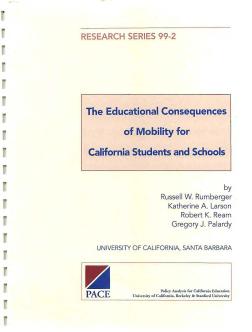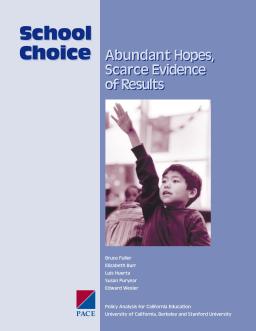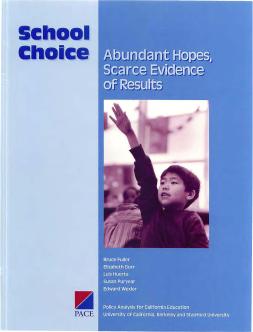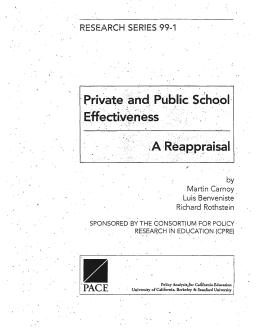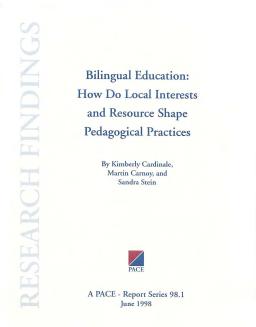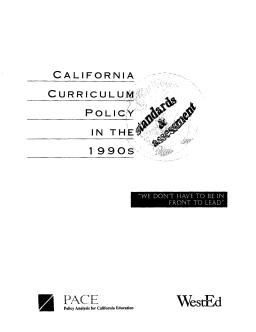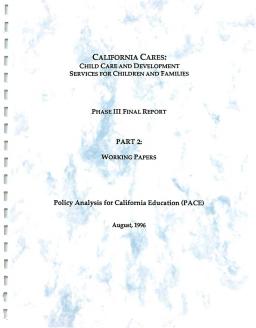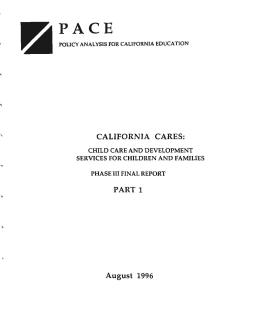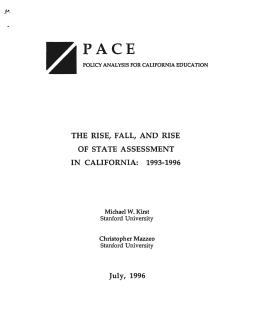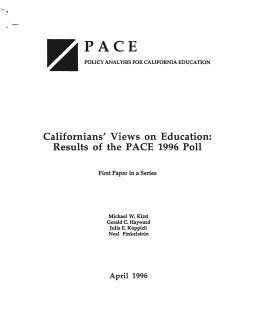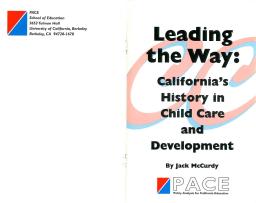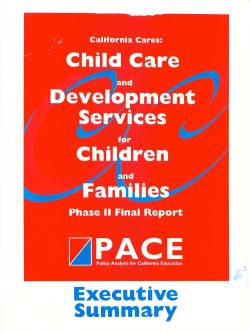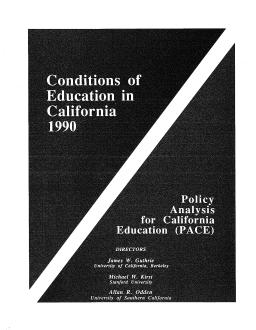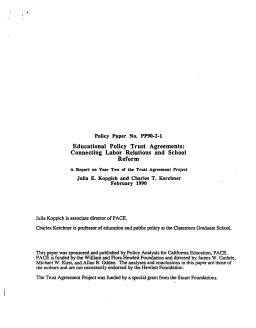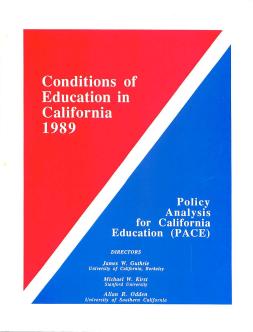Published
Summary
Student mobility, or non-promotional school changes, is a widespread problem that harms students' educational achievement. This report examines the incidence, consequences, and causes of mobility among California students and schools, drawing on surveys of students, parents, and schools, interviews with mobile students and their parents, and interviews with school administrators, counselors, and teachers. The report summarizes the findings on the causes and consequences of mobility and offers strategies for reducing needless mobility and mitigating its harmful effects.
Abundant Hopes, Scarce Evidence of Results—Executive Summary
Published
Summary
Public education in the US is widely criticized and everyone wants to reform it, but there's no consensus on the best strategy for improvement. This report focuses on school choice, a reform avenue gaining steam in California and the US, to explore policies and institutional changes that can boost children's learning.
Abundant Hopes, Scarce Evidence of Results
Published
Summary
Public education receives criticism from various stakeholders. Despite satisfaction with local elementary schools, overall quality concerns prevail. There is no consensus on the best approach to improve schools. PACE report investigates school choice, which is a reform strategy gaining popularity in California and beyond.
A Reappraisal
Published
Summary
This report challenges the belief that public schools are ineffective due to a lack of accountability for producing high academic achievement. Some argue that private management is necessary for improvement, but this report seeks to analyze the range of responses that schools have to accountability and determine whether market forces are necessary for improvement.
How Do Local Interests and Resources Shape Pedagogical Practices?
Published
Summary
Bilingual education implementation varies by district due to discourse and policies. Four issues affecting implementation are teacher recruitment, "ghettoization" of bilingual education, race relations, and community consensus. National debates impact local administrative actions, defining bilingual education practice. The report analyzed four California school districts to show the impact of these four issues on program design.
California Families Face Gaps in Preschool and Child Care Availability
Published
Summary
This report highlights the unequal distribution of preschool and childcare opportunities in California. Despite spending $1.2 billion annually, half of preschool-age children live in households with working mothers, with enrollment dependent on income and location. Counties vary greatly in their supply, with affluent parents more likely to find preschool or childcare slots. Latino children are hit hardest, even in counties with ample supply, with supply in predominantly Latino areas half that of low-income Black or Anglo communities.
Standards and Assessments
Published
Summary
This study traces California's curriculum-related reforms in mathematics and science during the 1990s, examining the role of the California Department of Education and the state's shifting political and policy context. It analyzes the perceptions of state officials, experts, and the public and how they influenced state policy changes. The authors raise questions about problems associated with curriculum policy in California and presents policy recommendations mentioned during interviews and document analysis. The study does not assess the impact of curriculum on school practice.
Child Care and Development Services for Children and Families—Phase III Final Report, Part 2
Published
Summary
Phase III of the California Cares report sought to analyze preliminary recommendations and involve the childcare and development community to redesign policies. Work groups and field representatives discussed proposals for improving services, with over 80 contributors. The project studied nine critical policy restructuring questions and Part Two of the report includes reports from eight tasks and summary information.
Child Care and Development Services for Children and Families—Phase III Final Report, Part 1
Published
Summary
Phase III of the California Cares report aimed to redesign childcare and development policy, with input from the community and representatives from three agencies. Work groups and traditional research projects were conducted to study nine questions deemed critical to policy restructuring. Part II of the report includes working papers for all tasks except state governance, which is included in Phase III.
1993–96
Published
Summary
The California Learning Assessment System (CLAS) was created in 1991 to replace its predecessor and align California's testing system with state curricular frameworks, measure attainment of content through performance-based assessment, and provide individual student assessment. However, objections from various groups led to its discontinuation. CLAS serves as an example of the difficulties in implementing authentic forms of assessment and the politics involved in testing policy reform in the United States.
Results of the PACE 1996 Poll
Published
Summary
A 1996 statewide poll by PACE surveyed Californians on their views and expectations for public schools, informing policy discussions. Results revealed four broad themes and their relevance to ongoing education policy discussions, such as redesigning statewide assessments, reforming traditional school governance, providing public funds for private schools, and complex issues of local control. PACE believes public perceptions should be considered in policy discussions, although education policy should not be solely based on public opinion polls.
California's History in Child Care and Development
Published
Summary
New curriculum manuals have been created to address the expanding field of school-age childcare, including Kids' Time: A School-Age Care Program Guide. Other widely-recognized materials include Just Kids, Preparing for Mass Disasters, and A Guide for Training and Recruiting Child Care Providers to Serve Young Children with Disabilities. The benefits of childcare include fully-employed parents, self-sufficient families, and children who succeed in school due to the aid of childcare programs. Reducing Exceptional Stress and Trauma, a guide on coping with violence, will be published this year.
Child Care and Development Services for Children and Families—Phase II Final Report Executive Summary
Published
Summary
The California Cares Project, conducted by PACE for the California Department of Education, Social Services & Office of Child Development & Education, culminates in this report. The project was initiated in response to AB 2184, which sought to consolidate all childcare and development programs to streamline the system. The report is divided into two parts: Part I analyzes current obstacles to a seamless system and Part II presents a conceptual model and decision procedure for program and funding allocation and governance. Phase III will refine recommendations and work towards implementation.
Child Care and Development Services for Children and Families—Phase I Final Report
Published
Summary
The California Department of Education, Social Services, and Governor's Office of Child Development and Education selected PACE to analyze issues and options for improving California's childcare system. PACE will produce a report with optional approaches for improving access, quality, and funding of childcare services, including alternative systems and policy models. Phase I includes analysis of childcare issues and programs, literature reviews, and experiences of other urban states. This report summarizes Phase I's work.
Published
Summary
This is the ninth edition of Conditions of Education in California. In this volume, PACE has compiled information on current critical issues in state education policy and presented them within the context of major policy developments. "Evolving Context" introduces the current issues in the state and sets the stage for the remaining chapters, which are Assessment and Achievement, Finance, Teachers and Teaching, Integrated Children's Services, Child Care and Development Services, and School-to-Work.
Published
Summary
The seventh edition of Conditions of Education in California by PACE focuses on education policy issues in a national context. The report analyzes California's education data by placing it in multi-state, national, and international contexts. The report's first three chapters analyze evolving education policy issues, Sacramento political dynamics, and student achievement. The remaining three chapters provide longitudinal data on student enrollment, finance, and system characteristics. The report aims to provide a continuing picture of education in California.
Published
Summary
CA's education system is affected by external factors like shifting demographics, declining economics, and intensifying politics, limiting the traditional routes of local decision-making and property taxation. Although some districts show excellence and commitment, creating and sustaining a statewide education system to meet 21st-century expectations is difficult without a comprehensive reform plan. Political conflict over revenue earmarking and school reform distracts from education improvement. This report describes and analyzes these issues, suggesting a comprehensive set of solutions.
Connecting Labor Relations and School Reform: A Report on Year Two of the Trust Agreement Project
Published
Summary
The Trust Agreement Project, initiated in September 1987, is a joint effort of 12 California school districts and their teachers' unions. It enables teachers and school management to develop agreements on professional issues beyond the traditional scope of collective bargaining. The agreements cover topics like teacher evaluation and curriculum development, and aim to enhance educational capacity by promoting collective responsibility for educational processes and outcomes. The project appears to be altering decision-making processes and encouraging collaboration between unions and management.
Published
Summary
The study examines the Partnership Academies in California, which are designed to reduce high school dropout rates among at-risk students. Academies combine high school curriculum, technical courses, and support from local businesses, with funding based on student outcomes. Survey results indicate that Academy students had a lower dropout rate than comparison group students, were more likely to attend college, and earned higher wages while working and studying. Graduates from both groups reported being fairly satisfied with their high school preparation and achievements since graduation.
Published
Summary
This is the fifth edition of Conditions of Education in California. Over time, the content and format have changed in keeping with suggestions made by readers. This publication is based upon compilations and syntheses of information collected by other agencies and individuals. These sources are noted throughout the text. We wish here to express our appreciation to these others upon whose efforts we depend so heavily. Also, PACE undertakes a substantial amount of original data collection and analysis. We make specific mention of this throughout the text.
